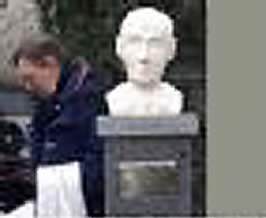The bronze bust of Raoul Wallenberg, aka the ‘Swedish Schindler’, was recently inaugurated in the inner patio of the Russian Library of Foreign Literature in Moscow. Wallenberg was a diplomat who managed to save thousands of Jewish lives during WWII. The bust by Italian artist Giampietro Cudin contains the inscription: ‘Raoul Wallenberg 1913 – ?’.
What makes the story curious is that no one knows for sure what happened to Wallenberg; a 10-year Swedish-Russian investigation has failed to ascertain whether the Swedish hero is alive or dead. What is clear, however, is that he was detained in Budapest in January 1945 and then taken to Russia. The Russian investigators claim he was executed in a KGB prison in 1947 but the Swedish contingent argue that the lack of evidence suggests he could have survived this fate and may instead have been checked into a Russian psychiatric hospital, as happened with other political prisoners towards the end of the war.
 Jan Wallenberg
Jan WallenbergJan Wallenberg, relative of the Swedish diplomat Raoul Wallenberg, passes by after unveiling the monument to his second cousin, in Moscow January 17, 2001. Russia reiterated its view that Wallenberg, who disappeared in 1945 after being arrested in Budapest by the Red Army, had been shot in 1947 in a Soviet prison.
